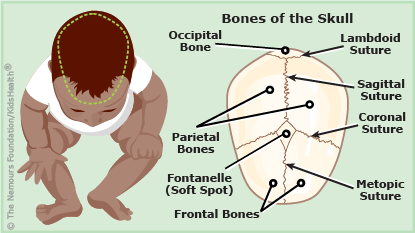Craniosynostosis
Article Translations: (Spanish)
What Is Craniosynostosis?
Craniosynostosis is when one or more seams between bones in a child's skull close too soon. When this happens, the skull can't grow as it should, and develops an unusual shape.
What Happens in Craniosynostosis?
Babies' skulls are made of several bones that fit together like a puzzle. At birth, the borders between the bones (called cranial sutures) are not yet solid. This lets the skull expand, leaving the "soft spot" (or fontanelle).
Normally, cranial sutures:
- flex and squeeze together a little, so that a baby's head can fit through the mother's pelvis during childbirth
- let the skull expand to make room for the baby's growing brain
- come together (fuse) when a child is 2–3 years old
But in craniosynostosis (kray-nee-oh-sin-oss-TOE-sis), one or more sutures close, either before birth or within a few months after. Craniosynostosis that's not corrected can cause pressure inside the skull (intracranial pressure). This can lead to developmental problems, headaches, and brain damage.

What Are the Signs & Symptoms of Craniosynostosis?
Kids with craniosynostosis have an irregular head shape. Their head may look smaller, longer, wider, or more narrow than usual. Or, the two sides of the head may be uneven.
Parents or doctors may not notice a baby has an unusual head shape until a few weeks after birth. That's because it's normal for a baby's head to change shape in the early weeks of life.
A baby with craniosynostosis may show signs there's a problem, such as:
- crying or being fussy
- being very sleepy or not very active
- a bulging fontanel (soft spot) on the top of the head
- not feeding well
What Causes Craniosynostosis?
Doctors don't always know why a child has craniosynostosis. Several health syndromes are linked to craniosynostosis, so doctors may recommend genetic testing.
How Is Craniosynostosis Diagnosed?
Sometimes, doctors see craniosynostosis on ultrasound scans before a baby is born. Other times, they find the condition when a baby is born or a few weeks later.
If doctors think a baby might have craniosynostosis, they may order tests, such as X-rays or a computed tomography (CT) scan. Then, they'll work with a neurosurgery team or a cleft and craniofacial team to confirm the diagnosis.
How Is Craniosynostosis Treated?
Often, a team of doctors works together to find the best treatment for a child with craniosynostosis. The team may include specialists in:
- neurosurgery: to treat nerve, brain, and spinal cord problems
- craniofacial plastic surgery
- ophthalmology: for eye problems
- genetics
- endocrinology: for hormone and mineral problems
- neurology: for nerve, brain, and spinal cord problems
- neonatology: for newborn intensive care
- speech-language pathology: to help with language delays
Babies with craniosynostosis usually need surgery during their first year of life. A neurosurgeon (sometimes with the help of a plastic surgeon) will remove the closed suture(s) to leave a gap between the pieces of bone that form the skull. Children who have surgery for craniosynostosis usually do well.
How Can Parents Help?
A baby with craniosynostosis needs regular checkups. During visits, the doctor will examine your baby and pay close attention to your child's development. The doctor will tell you if your child needs regular eye exams and other care to help with learning.
It is important to find a specialized cleft and craniofacial team to care for your child. Ask your doctor for recommendations. Or search online at:
It also can help to talk with other parents who have a child with craniosynostosis. Ask your doctor to recommend a local support group, or look online at:
Note: All information is for educational purposes only. For specific medical advice, diagnoses, and treatment, consult your doctor.
© 1995-2024 KidsHealth ® All rights reserved. Images provided by iStock, Getty Images, Corbis, Veer, Science Photo Library, Science Source Images, Shutterstock, and Clipart.com

